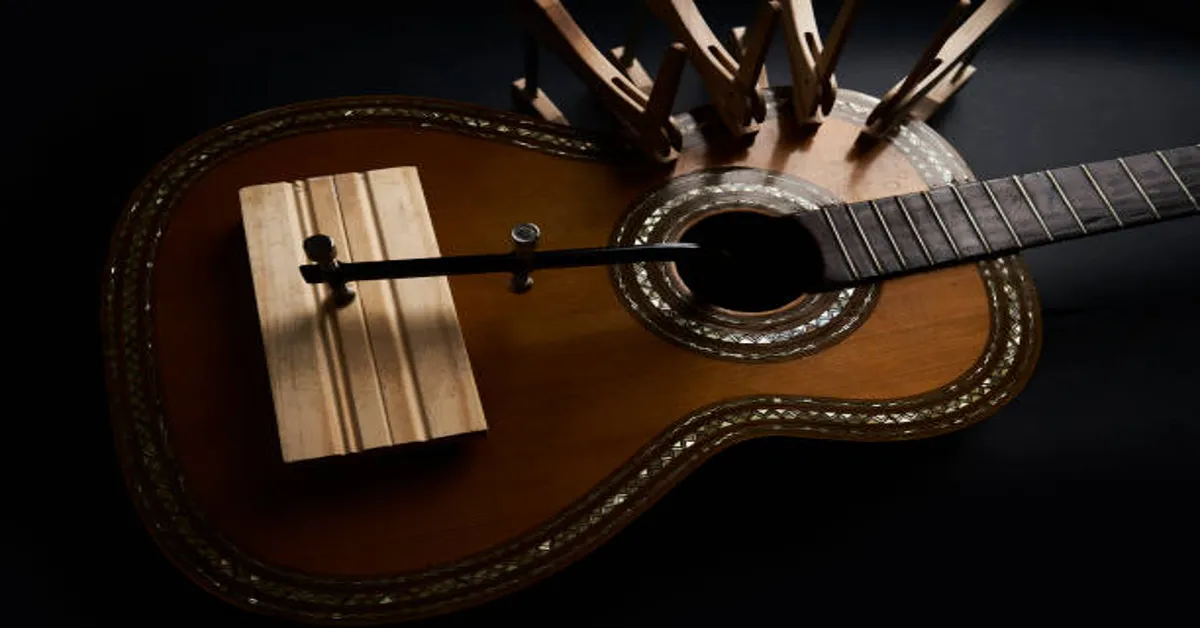The Requinto Guitar stands out as one of the most enchanting and specialized instruments in the string family. Though similar in shape and construction to the classical guitar, the Requinto offers a distinct tonal quality, higher pitch, and unique musical role that set it apart. While it may not be as universally recognized as the standard guitar, in certain musical circles—particularly within Latin American music—it is not only respected but celebrated for its melodic lead voice and lyrical clarity.
A smaller-bodied, higher-pitched relative of the classical guitar, the Requinto is more than just a novelty or an offshoot. It has its own defined space in musical ensembles, its own tuning standard, and its own cultural heritage. In this comprehensive exploration, we will unravel the many layers of this fascinating instrument: from its origins and historical development to its technical specifications, tuning system, sound qualities, and the role it plays in traditional and modern music. Whether you’re a musician, music lover, or curious researcher, this article will provide you with a full understanding of the Requinto Guitar and its significance.
Origins and Historical Development
The Requinto Guitar is believed to have originated in Spain and Mexico, evolving from the traditional Spanish guitar that was already well-established by the 19th century. Its development is closely tied to the evolution of romantic and folk music in Latin America, where the demand for a higher-pitched lead instrument grew in ensembles such as trios and bolero groups.
In Mexico, the Requinto became prominent in the early 20th century as part of the bolero trios that flourished during the golden age of romantic music. Groups such as Los Panchos famously incorporated the Requinto as the lead melodic instrument, giving it a prominent voice in Latin musical history. While guitars were already a staple of traditional and popular music, the Requinto added a new level of emotional expressiveness with its brighter, more penetrating tone.
Unlike some modern instruments that emerged from industrial design or academic experimentation, the Requinto Guitar evolved organically through musical practice. It was crafted to serve a specific need within musical groups—to play melodic lines, arpeggios, and ornamented phrases that would soar above rhythm guitars and vocal harmonies.
Design and Structure of the Requinto
Visually, the Requinto Guitar may resemble a scaled-down classical guitar, but every aspect of its design is carefully calibrated to produce its unique tonal qualities. The smaller size contributes to its higher pitch, while the choice of woods, string types, and bracing patterns all influence the final sound.
Typically, the Requinto measures around 530 to 540 mm in scale length, which is about 18% smaller than a standard classical guitar (which averages about 650 mm). This shorter scale allows for tighter string tension, higher tuning, and ease of fingering for quick melodic passages. The body itself is also smaller, usually more compact in both length and depth, which helps in producing a brighter, more focused sound.
The woods used in Requinto construction vary, but luthiers often favor the same tonewoods used in high-quality classical guitars. The top (soundboard) is commonly made of spruce or cedar, both known for their responsiveness and warmth. The back and sides might be crafted from rosewood, mahogany, or other dense hardwoods that add resonance and sustain.
In terms of hardware, most Requintos use nylon strings, similar to classical guitars. These strings offer a warm tone and are easier on the fingers, making them suitable for expressive vibrato and fast runs. Some modern Requintos use composite or carbon strings for added brightness and projection.
A good Requinto Guitar will also feature detailed craftsmanship, often with rosette inlays around the soundhole, decorative bindings, and custom tuners. This attention to detail is not just aesthetic—it often contributes to the instrument’s resonance, balance, and playability.
Tuning and Tonal Range
One of the defining features of the Requinto Guitar is its tuning, which sets it apart from standard guitars. It is typically tuned a perfect fourth higher than a standard classical guitar. While a classical guitar is tuned E-A-D-G-B-E from the lowest to highest string, the Requinto is usually tuned A-D-G-C-E-A. This shift in pitch transforms the instrument into a soprano or lead voice within an ensemble.
This tuning results in several important musical consequences. First, the Requinto can play in higher registers more easily without requiring players to move far up the fretboard. This makes it ideal for executing high-pitched melodies, counterpoint lines, and ornamental runs.
Second, the increased pitch makes the Requinto naturally more prominent in a mix of instruments. Its tones are bright, crisp, and focused, which allows it to cut through accompaniment parts and vocals. This makes it well-suited for solo passages or intricate fingerstyle pieces that benefit from clarity and projection.
Players must adjust to the different tuning if they are transitioning from a standard guitar, as chord shapes will produce different harmonies. However, many experienced guitarists find that the transition is not particularly difficult, and the skills are transferable.
Role in Musical Genres
The Requinto Guitar has a specialized but crucial role in many musical genres, particularly those rooted in Latin American tradition. While it may not be as common in rock, pop, or jazz (though exceptions do exist), it holds a position of honor in romantic, folk, and classical hybrid genres.
1. Bolero Music
In bolero trios, such as Los Panchos or Los Tres Ases, the Requinto is the melodic heart of the ensemble. It introduces the song with short instrumental phrases, fills in the spaces between vocal lines with melodic ornamentation, and sometimes takes full solos that express the emotional core of the piece.
2. Mariachi and Regional Mexican Music
Although not a standard member of mariachi groups (which favor the vihuela and guitarrón), the Requinto has occasionally found its way into modern or hybrid ensembles. In regional Mexican styles, the instrument is sometimes used for its lyrical lead capabilities, especially in acoustic or unplugged performances.
3. Andean and South American Folk Music
In various South American traditions, the Requinto has found utility as a lead instrument in folk ensembles, particularly where melodic clarity is prized. Its higher pitch allows it to weave in and out of flutes, charangos, and vocals with ease.
4. Modern and World Fusion
Some contemporary musicians have adopted the Requinto for use in world music or acoustic fusion projects. Its unique timbre adds a different color to arrangements, particularly when blended with other traditional instruments.
Requinto vs. Standard Guitar: Key Differences
Though the Requinto and standard classical guitar may seem similar at first glance, they are fundamentally different instruments in terms of sound, use, and function.
- Size and Scale: The Requinto is noticeably smaller, with a shorter scale length and more compact body.
- Tuning: Tuned a fourth higher (A-D-G-C-E-A) compared to E-A-D-G-B-E on a standard guitar.
- Musical Role: Primarily used for melody and lead lines, whereas the standard guitar often provides harmony and rhythm.
- Sound Profile: The Requinto has a brighter, more penetrating tone with an emphasis on higher frequencies.
- Technique: While techniques like fingerpicking, rasgueado, and tremolo are shared, the Requinto often emphasizes speed and clarity for melodic ornamentation.
Understanding these distinctions is important for musicians who wish to incorporate the Requinto into their work or appreciate its contribution to various musical traditions.
Playing Techniques and Styles
Playing the Requinto Guitar requires finesse, speed, and a strong command of melody. Because of its higher pitch and clarity, every note played is more exposed, meaning articulation and dynamics are crucial. Here are some of the common techniques used:
- Melodic Runs: Single-note lines are frequently used to create lyrical melodies or fast-paced riffs between vocal sections.
- Tremolo Picking: Similar to techniques used in classical guitar, tremolo provides sustain and emotional intensity to slower pieces.
- Arpeggios: Requinto players often use broken chords to harmonize melodies or fill in transitions.
- Slides, Pull-offs, and Hammer-ons: These add expression and fluidity, particularly in romantic or nostalgic pieces.
- Fingerstyle Picking: This allows for greater control over dynamics and nuance, which are essential for the Requinto’s expressive potential.
Many Requinto players use their fingernails or a combination of nails and pads for plucking the strings, which gives more tonal variety. Unlike some guitar styles that favor picks, Requinto music is almost always played with the fingers to allow for greater subtlety.
Requinto in Contemporary Music
Although most associated with traditional Latin American music, the Requinto Guitar has slowly gained attention in other styles. Some modern acoustic artists and indie musicians have experimented with it as an alternative to the ukulele or mandolin. Its unique voice adds a layer of sophistication and cultural texture that is hard to replicate with standard guitars.
There are also growing communities of Requinto enthusiasts on social platforms, where musicians share covers, lessons, and compositions that explore new ways to use the instrument. From fingerstyle arrangements of modern pop songs to original compositions that fuse classical and folk influences, the Requinto continues to evolve.
Buying and Maintaining a Requinto Guitar
Choosing a Requinto involves more than picking a smaller guitar off the shelf. Since it is a specialized instrument, quality varies widely depending on the builder, materials, and intended use.
When purchasing a Requinto, consider the following:
- Tuning Stability: Because of the higher tension, the instrument should have high-quality tuners and solid construction to hold pitch.
- Wood Quality: Tonewoods like spruce, cedar, and rosewood greatly impact the tonal richness.
- Craftsmanship: Pay attention to fretwork, bracing, and neck alignment.
- String Action: The strings should be close enough to allow fast melodic playing, but not so low that buzzing occurs.
Maintenance involves the same care as with any fine acoustic instrument: keep it in a stable, humidified environment, clean it regularly, and change strings as needed. Because the Requinto is often used for expressive lead playing, string quality is particularly important.
ALSO READ: Monoskiing: A Comprehensive Guide to the Unique Snow Sport
Frequently Asked Questions (FAQs)
1. What is the standard tuning of a Requinto Guitar?
The standard tuning of a Requinto Guitar is A-D-G-C-E-A, which is a perfect fourth higher than the standard guitar tuning. This higher pitch allows for brighter, more expressive melodic playing.
2. How is a Requinto different from a classical guitar?
A Requinto Guitar is smaller in size, has a shorter scale length, and is tuned a fourth higher than a classical guitar. It is primarily used for lead melodies, while classical guitars often handle rhythm and harmony.
3. What kind of music is the Requinto used in?
The Requinto is widely used in Latin American music, especially in bolero trios, romantic ballads, and regional folk traditions. It’s also used in modern acoustic and fusion genres by some contemporary artists.
4. Can a standard guitar player easily learn the Requinto?
Yes, a standard guitar player can adapt to the Requinto fairly easily. While chord shapes remain the same, they produce different pitches, and players must adjust to the shorter scale and brighter tone.
5. Is the Requinto suitable for solo performances?
Absolutely. The Requinto’s bright, expressive tone makes it ideal for solo performances, especially melodic pieces, romantic music, and instrumental compositions that require emotional nuance.










What i don’t realize is in truth how you’re now not actually
much more smartly-liked than you might be right
now. You’re very intelligent. You realize thus significantly relating to this topic, made me in my opinion consider it from so many varied angles.
Its like men and women don’t seem to be fascinated until it’s one
thing to accomplish with Girl gaga! Your individual stuffs outstanding.
All the time take care of it up!
6r421p
https://t.me/s/TgWin_1win/315
Thanx for the effort, keep up the good work Great work, I am going to start a small Blog Engine course work using your site I hope you enjoy blogging with the popular BlogEngine.net.Thethoughts you express are really awesome. Hope you will right some more posts.
https://t.me/s/Ofitsialnyy_win1
https://t.me/s/Official_1xbet_1xbet
https://t.me/s/Official_LEX_LEX
https://t.me/s/Official_1win_casino_1win
https://t.me/s/reyting_online_kazino/12/RTP_i_Expanding_Wilds
https://t.me/s/Official_1xbet_1xbet
Получи лучшие казинo России 2025 года! ТОП-5 проверенных платформ с лицензией для игры на реальные деньги. Надежные выплаты за 24 часа, бонусы до 100000 рублей, минимальные ставки от 10 рублей! Играйте в топовые слоты, автоматы и live-казинo с максимальны
https://t.me/s/RuCasino_top
Wow! This blog looks just like my oold one!
It’s on a entirely different topic but it has pretty much the same layout and
design. Great choice of colors!
Whats up very nice website!! Guy .. Excellent .. Superb .. I will bookmark your web site and take the feeds additionally?KI am satisfied to search out so many helpful info right here within the submit, we want work out extra techniques on this regard, thank you for sharing. . . . . .
https://t.me/s/a_official_1xbet
https://t.me/s/z_official_1xbet
https://t.me/s/Official_Pokerdomm
https://t.me/s/Casinosport_1win
https://t.me/s/Casinosport_1win
https://t.me/s/official_beef_beef
https://t.me/s/RuBeef_Casino
https://t.me/s/win_1_casino_play
https://t.me/s/win_1_play
I am continuously searching online for ideas that can help me. Thx!
https://t.me/s/win_1_casino_1_win
Do you have a spam issue on this site; I also am a blogger, and I was wanting to know your situation; many of us have developed some nice practices and we are looking to swap solutions with others, please shoot me an e-mail if interested.
WONDERFUL Post.thanks for share..extra wait .. …
Well I definitely liked reading it. This post offered by you is very effective for correct planning.
of course like your website however you need to check the spelling on quite a few of your posts. Many of them are rife with spelling issues and I find it very troublesome to tell the reality on the other hand I?¦ll certainly come again again.
Youre so cool! I dont suppose Ive read anything like this before. So good to seek out someone with some authentic thoughts on this subject. realy thanks for starting this up. this website is one thing that is wanted on the internet, someone with a little originality. useful job for bringing one thing new to the internet!
What i do not understood is in reality how you are no longer really a lot more neatly-favored than you may be right now. You’re very intelligent. You recognize thus significantly in terms of this topic, made me in my opinion consider it from numerous numerous angles. Its like women and men aren’t interested unless it is something to accomplish with Girl gaga! Your own stuffs great. Always handle it up!
Heya! I just wanted to ask if you ever have any trouble with hackers? My last blog (wordpress) was hacked and I ended up losing many months of hard work due to no back up. Do you have any methods to prevent hackers?
There may be noticeably a bundle to learn about this. I assume you made certain nice points in options also.
Цікавлять бонуси? казино з бонусами: актуальні акції, подарунки за реєстрацію, депозитні та VIP-бонуси. Чесно розбираємо правила, допомагаємо зрозуміти вигоду та уникнути типових помилок під час гри.
321chat free chat 321 sex
ORBS Production https://filmproductioncortina.com is a full-service film, photo and video production company in Cortina d’Ampezzo and the Dolomites. We create commercials, branded content, sports and winter campaigns with local crew, alpine logistics, aerial/FPV filming and end-to-end production support across the Alps. Learn more at filmproductioncortina.com
Хочешь развлечься? купить альфа пвп федерация – это проводник в мир покупки запрещенных товаров, можно купить гашиш, купить мефедрон, купить кокаин, купить меф, купить экстази, купить альфа пвп, купить гаш в различных городах. Москва, Санкт-Петербург, Краснодар, Владивосток, Красноярск, Норильск, Екатеринбург, Мск, СПБ, Хабаровск, Новосибирск, Казань и еще 100+ городов.
1win приложение 1win партнерская
бонуси казіно казино з бонусами
популярні слоти слоти онлайн
ігри в казино ігри в казино
oficjalny mostbet mostbet
aplikacja mostbet oficjalne kasyno mostbet
ігри в казино казіно ігри
новости беларуси сегодня новости беларуси 2025
https://t.me/Martin_officials
Enjoyed reading this
Стоит посмотреть: https://medim-pro.ru/kupit-spravku-o-gruppe-zdorovya/
https://t.me/s/RejtingTopKazino
Free video chat emerald chat app find people from all over the world in seconds. Anonymous, no registration or SMS required. A convenient alternative to Omegle: minimal settings, maximum live communication right in your browser, at home or on the go, without unnecessary ads.
https://t.me/s/ef_beef
This is very interesting, You are an excessively skilled blogger. I’ve joined your feed and look ahead to in the hunt for more of your fantastic post. Also, I’ve shared your web site in my social networks!
Read more on the website: https://www.e-vikariat-nordkirche.de/kupit-akkaunty-facebook-s-bm-marketplejs-darkstore-3/
https://t.me/s/Martin_casino_officials
Актуальная kraken onion ссылка содержится в официальных телеграм каналах администрации с многолетней историей публикаций и активной аудиторией подписчиков.
Нужна работа в США? курс трак диспетчера в сша вечерний формат : работа с заявками и рейсами, переговоры на английском, тайм-менеджмент и сервис. Подходит новичкам и тем, кто хочет выйти на рынок труда США и зарабатывать в долларах.
Its like you read my mind! You seem to know so much about this, like you wrote the book in it or something. I think that you can do with a few pics to drive the message home a little bit, but instead of that, this is magnificent blog. An excellent read. I’ll definitely be back.
independent escort girl in Rio
Impressive write-up
Uwielbiasz hazard? https://online-nv-casino.com: rzetelne oceny kasyn, weryfikacja licencji oraz wybor bonusow i promocji dla nowych i powracajacych graczy. Szczegolowe recenzje, porownanie warunkow i rekomendacje dotyczace odpowiedzialnej gry.
Expanded article here: http://news.austin-online.com/story/549068/the-ultimate-guide-to-buying-facebook-advertising-accounts-what-must-be-known.html
Криптографически защищенный кракен сайт онион версии v3 содержит 56 символов перед расширением точка onion и математически связан с публичными ключами серверов через эллиптические кривые.
Крупнейший кракен маркет даркнет предлагает тысячи продавцов с высоким рейтингом, проверенной репутацией и круглосуточной модерацией споров покупателей.
Leading store buy accounts is happy to present instant access to purchase high-quality credentials suitable for growth. What sets us apart of our shop lies in our in-depth learning center, where you can find fresh strategies on lead generation. We cover methods to manage ads securely and how to avoid bans while running social networks. Our inventory offers pages for Facebook, Instagram, TikTok for any purpose: ranging from freshly registered up to farmed profiles with history.
https://t.me/s/officials_1xbet_1xbet
Thanks for sharing superb informations. Your website is so cool. I am impressed by the details that you have on this blog. It reveals how nicely you understand this subject. Bookmarked this web page, will come back for more articles. You, my pal, ROCK! I found just the info I already searched all over the place and just could not come across. What a perfect web-site.
Exclusive vendor marketplace accounts welcomes webmasters to the comprehensive inventory of marketing tools. The pride of this platform lies in the availability of an private learning center, filled with fresh tutorials on social media marketing. We cover methods to warm up ads securely as well as strategies for bypassing bans while running Facebook, TikTok, or Google. Purchasing here, you get more than just valid accounts, as well as responsive support, replacement warranties and affordable rates on the market.
I wanted to thank you for this great read!! I definitely enjoying every little bit of it I have you bookmarked to check out new stuff you post…
You actually make it appear really easy with your presentation but I find this matter to be really one thing which I think I’d never understand. It kind of feels too complex and very vast for me. I am taking a look forward on your subsequent put up, I¦ll try to get the cling of it!
Hey very nice blog!! Guy .. Excellent .. Superb .. I will bookmark your site and take the feeds additionally…I’m satisfied to seek out so many useful info right here within the post, we’d like develop extra strategies on this regard, thank you for sharing. . . . . .
курсовые работы заказать [url=https://kupit-kursovuyu-24.ru/]курсовые работы заказать[/url] .
курсовой проект купить цена [url=kupit-kursovuyu-25.ru]kupit-kursovuyu-25.ru[/url] .
mostbet global mostbet pl
написать курсовую работу на заказ в москве [url=https://www.kupit-kursovuyu-27.ru]https://www.kupit-kursovuyu-27.ru[/url] .
студенческие работы на заказ [url=www.kupit-kursovuyu-28.ru]студенческие работы на заказ[/url] .
купить курсовую [url=https://kupit-kursovuyu-24.ru/]https://kupit-kursovuyu-24.ru/[/url] .
написание учебных работ [url=https://kupit-kursovuyu-25.ru/]https://kupit-kursovuyu-25.ru/[/url] .
kod promocyjny mostbet mostbet pl
выполнение учебных работ [url=http://www.kupit-kursovuyu-27.ru]http://www.kupit-kursovuyu-27.ru[/url] .
помощь студентам контрольные [url=kupit-kursovuyu-29.ru]помощь студентам контрольные[/url] .
заказать курсовую срочно [url=https://www.kupit-kursovuyu-28.ru]заказать курсовую срочно[/url] .
помощь курсовые [url=https://www.kupit-kursovuyu-24.ru]https://www.kupit-kursovuyu-24.ru[/url] .
где можно купить курсовую работу [url=http://kupit-kursovuyu-25.ru]http://kupit-kursovuyu-25.ru[/url] .
I’m extremely impressed with your writing skills and also with the layout on your weblog. Is this a paid theme or did you modify it yourself? Anyway keep up the nice quality writing, it is rare to see a nice blog like this one nowadays..
заказать курсовую срочно [url=www.kupit-kursovuyu-27.ru/]заказать курсовую срочно[/url] .
заказать курсовой проект [url=https://kupit-kursovuyu-29.ru]заказать курсовой проект[/url] .
заказать дипломную работу в москве [url=http://kupit-kursovuyu-28.ru/]http://kupit-kursovuyu-28.ru/[/url] .
заказать качественную курсовую [url=www.kupit-kursovuyu-24.ru]заказать качественную курсовую[/url] .
написание учебных работ [url=www.kupit-kursovuyu-25.ru/]www.kupit-kursovuyu-25.ru/[/url] .
выполнение курсовых [url=http://kupit-kursovuyu-27.ru/]выполнение курсовых[/url] .
курсовая работа купить [url=kupit-kursovuyu-29.ru]курсовая работа купить[/url] .
дипломные работы на заказ [url=https://www.kupit-kursovuyu-28.ru]https://www.kupit-kursovuyu-28.ru[/url] .
сайт заказать курсовую работу [url=www.kupit-kursovuyu-29.ru]сайт заказать курсовую работу[/url] .
фен дайсон цена купить [url=http://fen-ds-1.ru]http://fen-ds-1.ru[/url] .
дайсон стайлер для волос купить цена с насадками официальный сайт [url=http://fen-d-1.ru/]http://fen-d-1.ru/[/url] .
дайсон стайлер для волос купить цена официальный сайт с насадками [url=fen-ds-2.ru]fen-ds-2.ru[/url] .
фен дайсон купить официальный сайт [url=https://www.fen-ds-4.ru]фен дайсон купить официальный сайт[/url] .
купить фен дайсон официальный сайт [url=dn-fen-3.ru]купить фен дайсон официальный сайт[/url] .
фен купить дайсон официальный сайт [url=https://dn-fen-2.ru/]dn-fen-2.ru[/url] .
дайсон фен купить официальный сайт [url=http://dn-fen-1.ru]http://dn-fen-1.ru[/url] .
дайсон фен официальный сайт [url=https://www.fen-d-2.ru]дайсон фен официальный сайт[/url] .
La plateforme 1xbet burkina apk: paris sportifs en ligne, matchs de football, evenements en direct et statistiques. Description du service, marches disponibles, cotes et principales fonctionnalites du site.
Site web de pari foot rdc: paris sportifs, championnats de football, resultats des matchs et cotes. Informations detaillees sur la plateforme, les conditions d’utilisation, les fonctionnalites et les evenements sportifs disponibles.
Site web 1xbet apk rdc – paris sportifs en ligne sur le football et autres sports. Propose des paris en direct et a l’avance, des cotes, des resultats et des tournois. Description detaillee du service, des fonctionnalites du compte et de son utilisation au Congo.
La plateforme en ligne 1xbet apk: paris sportifs en ligne, matchs de football, evenements en direct et statistiques. Description du service, marches disponibles, cotes et principales fonctionnalites du site.
Application mobile 1xbet apk burkina. Paris sportifs en ligne, football et tournois populaires, evenements en direct et statistiques. Presentation de l’application et de ses principales fonctionnalites.
dyson official [url=https://fen-ds-2.ru/]https://fen-ds-2.ru/[/url] .
дайсон стайлер купить официальный [url=https://dn-fen-3.ru]https://dn-fen-3.ru[/url] .
стайлер для волос дайсон с насадками официальный сайт купить цена [url=http://fen-ds-4.ru]http://fen-ds-4.ru[/url] .
dyson официальный сайт в россии [url=http://fen-ds-1.ru]http://fen-ds-1.ru[/url] .
сайт дайсон официальный в россии [url=http://dn-fen-2.ru/]http://dn-fen-2.ru/[/url] .
дайсон официальный сайт [url=http://www.fen-d-1.ru]http://www.fen-d-1.ru[/url] .
фен дайсон официальный сайт [url=http://dn-fen-1.ru/]http://dn-fen-1.ru/[/url] .
официальный сайт дайсон в россии каталог цены [url=https://fen-d-2.ru/]fen-d-2.ru[/url] .
стайлер дайсон для волос цена с насадками официальный сайт купить [url=https://fen-ds-2.ru]https://fen-ds-2.ru[/url] .
дайсон стайлер для волос цена с насадками купить официальный сайт [url=http://www.dn-fen-3.ru]http://www.dn-fen-3.ru[/url] .
стайлер дайсон для волос купить официальный сайт с насадками цена [url=fen-ds-4.ru]fen-ds-4.ru[/url] .
фен дайсон официальный сайт [url=https://fen-ds-1.ru]https://fen-ds-1.ru[/url] .
дайсон стайлер для волос с насадками цена купить официальный сайт [url=https://dn-fen-2.ru/]dn-fen-2.ru[/url] .
La plateforme telecharger 1xbet burkina faso: paris sportifs en ligne, matchs de football, evenements en direct et statistiques. Description du service, marches disponibles, cotes et principales fonctionnalites du site.
Site web 1xbet apk rdc – paris sportifs en ligne sur le football et autres sports. Propose des paris en direct et a l’avance, des cotes, des resultats et des tournois. Description detaillee du service, des fonctionnalites du compte et de son utilisation au Congo.
Site web de parifoot rd congo: paris sportifs, championnats de football, resultats des matchs et cotes. Informations detaillees sur la plateforme, les conditions d’utilisation, les fonctionnalites et les evenements sportifs disponibles.
La plateforme en ligne 1xbet apk: paris sportifs en ligne, matchs de football, evenements en direct et statistiques. Description du service, marches disponibles, cotes et principales fonctionnalites du site.
фен дайсон официальный сайт цена [url=http://dn-fen-1.ru/]http://dn-fen-1.ru/[/url] .
стайлер купить дайсон официальный сайт [url=http://fen-d-1.ru/]http://fen-d-1.ru/[/url] .
Application mobile telecharger 1xbet apk. Paris sportifs en ligne, football et tournois populaires, evenements en direct et statistiques. Presentation de l’application et de ses principales fonctionnalites.
официальный сайт дайсон [url=http://dn-fen-3.ru]официальный сайт дайсон[/url] .
dyson официальный сайт в россии [url=http://fen-ds-2.ru/]http://fen-ds-2.ru/[/url] .
оригинальный фен dyson [url=www.fen-d-2.ru/]www.fen-d-2.ru/[/url] .
дайсон стайлер официальный сайт [url=https://fen-ds-4.ru/]дайсон стайлер официальный сайт[/url] .
купить дайсон стайлер с насадками для волос официальный сайт цена [url=https://fen-ds-1.ru/]https://fen-ds-1.ru/[/url] .
стайлер дайсон для волос с насадками купить официальный сайт цена [url=https://dn-fen-2.ru/]dn-fen-2.ru[/url] .
дайсон стайлер для волос официальный сайт с насадками купить цена [url=www.dn-fen-1.ru/]www.dn-fen-1.ru/[/url] .
дайсон фен купить официальный сайт [url=https://fen-d-1.ru/]https://fen-d-1.ru/[/url] .
фен купить дайсон официальный сайт [url=fen-d-2.ru]fen-d-2.ru[/url] .
Great job on this comprehensive piece! Its informative, engaging, and packed with actionable tips that I can use right away.